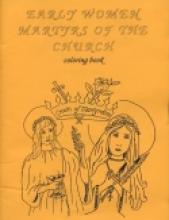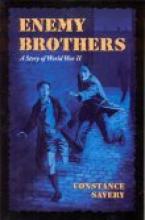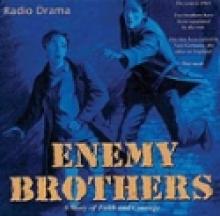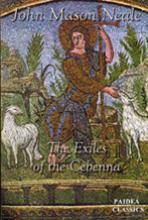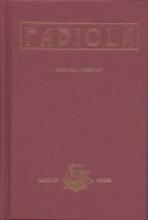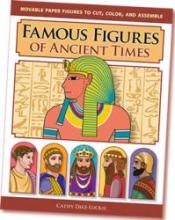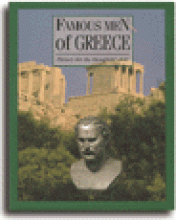History
Early Women Martyrs of the Church: Coloring book
Subject(s):
Setting:
Grade / Age level:
Review:
Portraits of 12 saints--from St. Philomena to St. Lucy--are portrayed in large ready-to-color illustrations alongside a brief description of the martyr. This 8 1/2" x 11" coloring book has a soft cover and staple binding making it easy to lay open for coloring. The saints are depicted with the common symbols telling about their life and death and the descriptions are simple and short enough that they can be enjoyed by a child as young as 5 or 6 years old. This coloring book would be a nice introduction to the early church and saint symbols for a young child or as a supplement to a history course for children up to age 10 or 12.
Reviewed by:
First reviewed:
1998-99
Enemy Brothers
A Story of World War II
Subject(s):
Setting:
Grade / Age level:
Review:
After being very impressed with Constance Savery's insightful writing style and unique plot line in The Reb and the Redcoats, I had rather high expectations for Enemy Brothers. I wasn't disappointed in the least. This story is set in the early years of World War II (before the United States joined the Allied Forces) and tells of a young British man (Dym) whose toddler-aged brother was kidnapped from their large family ten years earlier. Dym loses both his parents within a short time of the kidnapping, but promises his mother before she dies to continue to search for little Tony. He spends many years in Germany and Switzerland looking for the boy, studying the books that his brother might be brought up on, but has to return to England when war breaks out. As an officer in the British Air Force, Dym is introduced to a young lad (Max) from Germany who has been captured and brought to England because of his pro-Nazi escapades in Norway. Known to be a real trouble-maker, his captors have a difficult time finding a place for him to live. Dym, suspecting that this is his long-lost brother (who was raised in the Nazi ideology) offers to take him home to the family estate the White Priory (fans of The Reb and the Redcoats, will recognize the same house from a different era). Although evidence mounts againts him, Max insists that he is not Tony and demands to be sent back to Germany. He lives up to his reputation for trouble by attempting numerous escapes, playing harmful pranks and even trying to spy for his home country right under their noses. The plot is thoughtful, engaging and not at all "predictable".
The story is a classic tale of the conflict between good and evil, love and hate - particularly on an intellectual level (the plane in which so many of today's moral conflicts lie). Much of Max's indoctrination is of an intellectual nature and I appreciate the fact that the good side is portrayed as fighting on God's side, despite errors of judgment in the past. The story is filled with interesting details of the time period. As I read the story, I found myself stopping frequently to comment to my husband about this or that aspect of the way things were during World War II, that I had never heard of elsewhere.
The writing quality and the beautiful way the author describes certain subtleties (such as how Max slowly discovers how different life in England is from life in Germany and how much of his beliefs about the English were simply German propaganda) are just wonderful. The thoughtfulness of the scenes in portraying some of these details makes the reading very enjoyable for adults as well as children. In some cases, as a family read-aloud, these scenes may require a little explanation for the younger children. A few tidbits made me and my husband laugh out loud which prompted the children to beg for an explanation! Overall, we have found that our children really love these opportunities to stop and talk about the story a bit and these tangents can be one of the real blessings of reading books as a family.
Although the story touches upon some intense and difficult concepts, like the Reb and the Redcoats, it is presented in such a manner as to be appropriate for a wide age range and could be used as a family read-aloud. The conflicts and relationships between the main characters of the story provide a beautiful opportunity to thoughtfully consider how our actions and example can affect the moral decisions of others. Highly recommended.
The story is a classic tale of the conflict between good and evil, love and hate - particularly on an intellectual level (the plane in which so many of today's moral conflicts lie). Much of Max's indoctrination is of an intellectual nature and I appreciate the fact that the good side is portrayed as fighting on God's side, despite errors of judgment in the past. The story is filled with interesting details of the time period. As I read the story, I found myself stopping frequently to comment to my husband about this or that aspect of the way things were during World War II, that I had never heard of elsewhere.
The writing quality and the beautiful way the author describes certain subtleties (such as how Max slowly discovers how different life in England is from life in Germany and how much of his beliefs about the English were simply German propaganda) are just wonderful. The thoughtfulness of the scenes in portraying some of these details makes the reading very enjoyable for adults as well as children. In some cases, as a family read-aloud, these scenes may require a little explanation for the younger children. A few tidbits made me and my husband laugh out loud which prompted the children to beg for an explanation! Overall, we have found that our children really love these opportunities to stop and talk about the story a bit and these tangents can be one of the real blessings of reading books as a family.
Although the story touches upon some intense and difficult concepts, like the Reb and the Redcoats, it is presented in such a manner as to be appropriate for a wide age range and could be used as a family read-aloud. The conflicts and relationships between the main characters of the story provide a beautiful opportunity to thoughtfully consider how our actions and example can affect the moral decisions of others. Highly recommended.
Additional notes:
This book was donated for review by Bethlehem Books
Reviewed by:
First reviewed:
8-15-01
Enemy Brothers Audio Drama
Subject(s):
Setting:
Grade / Age level:
Resource Type:
Review:
Kidnapped as a baby, Tony, now age 12, was raised as a German. In fact, as he grew up with an entirely different identity as "Max", he never had any reason to believe that he was anything but German. Suddenly, through a strange twist of fate, he is returned to his rightful home in England and his true identity, but on the "wrong" side of the war.
Under any circumstances the transition would be traumatic, but now, with the outbreak of World War II, he is thrown into total disarray. Refusing to believe that he is English, Tony makes several attempts to escape from his new home. Then unexpectedly, he is given the chance to return "home" to his "mother" and to Germany, to be "Max" once again. Will he leave England, a country he was taught to hate in the Hitler youth, and his true family, whose values are so different? The consistent, loving patience of his siblings in the midst of his atrocious behavior is a beautiful and essential part of the story that dramatically shows Gospel-like attitudes to be the right answer.
Enemy Brothers exemplifies the eternal struggle within us. It is a story of the battle between good over evil, love versus hatred, kindness and goodness against anger and mistrust, sacrifice and the bearing of another's faults instead of revenge, and ultimately hope in the goodness of human heart. Will love triumph in the end?
In addition to the great story of conflict and suspense, this radio drama offers interesting sound effects and bits of historical recordings; all creating the feel that you are there. The well-done script smoothly interweaves narrator, music, sound effects and superb voices. This is a first rate production!
Under any circumstances the transition would be traumatic, but now, with the outbreak of World War II, he is thrown into total disarray. Refusing to believe that he is English, Tony makes several attempts to escape from his new home. Then unexpectedly, he is given the chance to return "home" to his "mother" and to Germany, to be "Max" once again. Will he leave England, a country he was taught to hate in the Hitler youth, and his true family, whose values are so different? The consistent, loving patience of his siblings in the midst of his atrocious behavior is a beautiful and essential part of the story that dramatically shows Gospel-like attitudes to be the right answer.
Enemy Brothers exemplifies the eternal struggle within us. It is a story of the battle between good over evil, love versus hatred, kindness and goodness against anger and mistrust, sacrifice and the bearing of another's faults instead of revenge, and ultimately hope in the goodness of human heart. Will love triumph in the end?
In addition to the great story of conflict and suspense, this radio drama offers interesting sound effects and bits of historical recordings; all creating the feel that you are there. The well-done script smoothly interweaves narrator, music, sound effects and superb voices. This is a first rate production!
Additional notes:
2 CDs, 90 minutes
Reviewed by:
First reviewed:
5-23-05
Escape from Warsaw
Number of pages:
218 pages
Publisher:
Scholastic
Binding:
Softcover
Subject(s):
Setting:
Grade / Age level:
Review:
Escape from Warsaw, also known as the Silver Sword, is a very historically accurate account (based on a conglomeration of many true stories) of a Polish family who are separated by war and struggle and find each other again through many hardships. An interesting and likeable story beloved by many, it's a great read for ages ten and up.
Reviewed by:
First reviewed:
10-13-03
Everybody Cooks Rice
Grade / Age level:
Review:
A small illustrated children's book about two children who visit a number of their neighbors of different ethnic backgrounds and discover that each of their cultures uses rice in their cooking. Includes recipes in the back. A good way to introduce children to our country's ethnic diversity without getting "politically correct." (Warning: We get hungry every time we read this book.)
Reviewed by:
First reviewed:
1998-99
Exiles of the Cebenna
Subject(s):
Setting:
Grade / Age level:
Review:
I came across this little gem of a story from the 19th century while visiting the Paidea Classics website. This is a website with resources for Eastern Orthodox home schooling families. If you are studying the time period of the early Church you will find a lot of primary sources and resources there.
Exiles of the Cebenna was originally written in the 19th century and pretends to be the long lost journal of a priest from the 3rd century. The language is delightful and the story very moving. It takes place at the time of the persecution by Decius, a particularly brutal time of martyrdom. The people of Arles, France have been told that they must appear at the arena to give sacrifice to the Roman gods. If they refuse, they will be tortured and killed. A small group of Christians under the leadership of the priest telling the story plan an escape through a secret tunnel. The Bishop however, must stay behind.
On the day of his appointed appearance, the Bishop quails under the torture and makes the sacrifice. He is utterly devastated that he could not bear witness to his faith and has failed his people. Hearing of this, his daughter who was one of the escapees, tries to return to see her father and comfort him. Since the tortures, the people and officials are subdued by the horrific spectacle, and the Christians feel that it is now safe to travel in the open. They are recognized however and taken to the prison. The daughter is told that she must sacrifice. She refuses, and in the most moving scene in the book begins her torture. Her life is spared at the last moment, but she does eventually die from her wounds. Her death indeed helps her father to proclaim his faith, and, according to the epilogue, he is also eventually martyred.
Although, a student may have trouble getting into the language of the story at first, it does become more readable and draws the reader in. The ending is worth every word of the rest of the book. It gives a truly inspiring image of the trials and glory of the martyrs.
Recommended for 7th grade and up.
Exiles of the Cebenna was originally written in the 19th century and pretends to be the long lost journal of a priest from the 3rd century. The language is delightful and the story very moving. It takes place at the time of the persecution by Decius, a particularly brutal time of martyrdom. The people of Arles, France have been told that they must appear at the arena to give sacrifice to the Roman gods. If they refuse, they will be tortured and killed. A small group of Christians under the leadership of the priest telling the story plan an escape through a secret tunnel. The Bishop however, must stay behind.
On the day of his appointed appearance, the Bishop quails under the torture and makes the sacrifice. He is utterly devastated that he could not bear witness to his faith and has failed his people. Hearing of this, his daughter who was one of the escapees, tries to return to see her father and comfort him. Since the tortures, the people and officials are subdued by the horrific spectacle, and the Christians feel that it is now safe to travel in the open. They are recognized however and taken to the prison. The daughter is told that she must sacrifice. She refuses, and in the most moving scene in the book begins her torture. Her life is spared at the last moment, but she does eventually die from her wounds. Her death indeed helps her father to proclaim his faith, and, according to the epilogue, he is also eventually martyred.
Although, a student may have trouble getting into the language of the story at first, it does become more readable and draws the reader in. The ending is worth every word of the rest of the book. It gives a truly inspiring image of the trials and glory of the martyrs.
Recommended for 7th grade and up.
Reviewed by:
First reviewed:
1998-99
Fabiola, or the Church of the Catacombs
Number of pages:
616 pages
Copyright:
1997
Publisher:
Lepanto Press
Binding:
Sewn Hardcover
Subject(s):
Setting:
Grade / Age level:
Review:
Late in the third century, under the rule of the barbarian Diocletian, began the last and one of the most severe persecutions of Christians in early church history. During this time Sts. Sebastian, Agnes, and Tarcisius, among many others, won the martyr's crown. This book gives an account of their witness.
Fabiola is a Roman lady, a "noble pagan" of intelligence, virtue and spirit, who like many Romans of the time has heard nothing but false, vile reports of Christian beliefs and practices. At the same time she can't help contrasting the behavior of her young cousin, Agnes, her friend Sebastian, and her slave Syra with the corrupt brutality so rampant in pagan society. Without knowing that they are Christians, she senses that they are in light while she is still in darkness.
While Fabiola and her journey towards conversion is the focal point of the book, there are as many turns and side passages in the plot as there are in the catacombs. There is a subplot concerning an immature Christian who falls into apostasy and betrays his friends - but repents and is restored to grace. Another subplot concerns a martyr's son who longs to follow in his father's footsteps. A chapter is devoted to explaining the purpose of the catacombs and how the inscriptions came to be written within them. There is a lot to be learned from this book about an important time in Christian history. The descriptions of the martyrs' deaths are realistic, and because of this, and the length and ornate style of the book, it might be best read by teenagers and adults.
Fabiola is a Roman lady, a "noble pagan" of intelligence, virtue and spirit, who like many Romans of the time has heard nothing but false, vile reports of Christian beliefs and practices. At the same time she can't help contrasting the behavior of her young cousin, Agnes, her friend Sebastian, and her slave Syra with the corrupt brutality so rampant in pagan society. Without knowing that they are Christians, she senses that they are in light while she is still in darkness.
While Fabiola and her journey towards conversion is the focal point of the book, there are as many turns and side passages in the plot as there are in the catacombs. There is a subplot concerning an immature Christian who falls into apostasy and betrays his friends - but repents and is restored to grace. Another subplot concerns a martyr's son who longs to follow in his father's footsteps. A chapter is devoted to explaining the purpose of the catacombs and how the inscriptions came to be written within them. There is a lot to be learned from this book about an important time in Christian history. The descriptions of the martyrs' deaths are realistic, and because of this, and the length and ornate style of the book, it might be best read by teenagers and adults.
Perspective:
Catholic
Additional notes:
Originally published in the late 19th century, reprinted by Lepanto Press
Reviewed by:
First reviewed:
1998-99
Famous Figures of Ancient Times
Movable Paper Figures to Cut, Color and Assemble
Subject(s):
Grade / Age level:
Resource Type:
Review:
This is a fun and colorful book of cut-out paper dolls that you assemble with small brads or brass fasteners (available from an office supply store), allowing the arms and legs to be moved and posed.
The book is printed on heavy cardstock (with perforated pages for easy removal) and there are two copies of each paper doll – one in full color and one ready to be colored.
There are 20 historical figures included, making a total of 40 paper dolls. These are the historical figures represented: Narmer, Khufu, Sargon the Great, Hammurabi, Moses, King David, Ashurbanipal, Nebuchadnezzar II, Cyrus the Great, A Greek Hoplite, Aristotle, Alexander the Great, Qin Shi Huangdi, Hannibal, Hannibal’s Elephant (a great favorite among my younger children!), Julius Caesar, Caesar Augustus, Jesus, Constantine and Augustine.
My children are very much enjoying working with this book and even my eight year old was successful at cutting the pieces out and assembling them herself. Having two copies of each doll made it especially enjoyable to share among four children and I really appreciate that they have the name of each character printed on the back of the doll, so you don’t have to worry about keeping track.
The book also includes a very brief, even cryptic biography of each historical figure. Just enough information to help get the names straight.
Additional notes:
More info available at the publisher's website: www.figuresinmotion.com
Reviewed by:
First reviewed:
3-10-2010
Famous Men of Greece
Subject(s):
Setting:
Grade / Age level:
Review:
Like Famous Men of Rome, Famous Men of Greece introduces ancient history in the manner of Plutarch, by means of thirty-one short (4-5 page) biographies of the great men of Ancient Greece. It begins back at the point where history merges with legend, and ends with the fall of Greece to Rome in 146 B.C.
The introduction gives a brief description of the pantheon of mythical gods and goddesses of Greece. The book explains that this is how the Greek citizen of ancient times would have started with the historical record -- that though we call these stories "myths" now, they tell us something about how the people thought in those days. From there, the first nine chapters cover figures of legend -- where possible truth is mixed with make-believe. These stories are also important to Greek history, because they show what the Greeks valued in their heroes and the stories they learned and told to each other. Starting with Chapter X on Lycurgus the Spartan who lived in the 9th century B.C., we reach the actual historical record. The book advises the student to learn to discern between history, legend and myth in his reading and to ask himself "What things in this story could really have happened?"
My children, who use this book as a history spine in 4th grade, have all loved these tales of Greek heroes and statesmen. In addition to showing the continuum between legend and historical records, these books provide what to me is of first importance: lessons in evaluating people and events through an ethical, Christian perspective. History learned by stories is more easily remembered for children grades 3 to 7 than lists of facts and details to memorize for tests. Also, this is the way the ancients themselves learned and wrote history; showing the importance of their values through the lives of their good and their bad leaders.
The introduction gives a brief description of the pantheon of mythical gods and goddesses of Greece. The book explains that this is how the Greek citizen of ancient times would have started with the historical record -- that though we call these stories "myths" now, they tell us something about how the people thought in those days. From there, the first nine chapters cover figures of legend -- where possible truth is mixed with make-believe. These stories are also important to Greek history, because they show what the Greeks valued in their heroes and the stories they learned and told to each other. Starting with Chapter X on Lycurgus the Spartan who lived in the 9th century B.C., we reach the actual historical record. The book advises the student to learn to discern between history, legend and myth in his reading and to ask himself "What things in this story could really have happened?"
My children, who use this book as a history spine in 4th grade, have all loved these tales of Greek heroes and statesmen. In addition to showing the continuum between legend and historical records, these books provide what to me is of first importance: lessons in evaluating people and events through an ethical, Christian perspective. History learned by stories is more easily remembered for children grades 3 to 7 than lists of facts and details to memorize for tests. Also, this is the way the ancients themselves learned and wrote history; showing the importance of their values through the lives of their good and their bad leaders.
Additional notes:
Copyrights 1904/1989
Reviewed by:
First reviewed:
9-2-04

